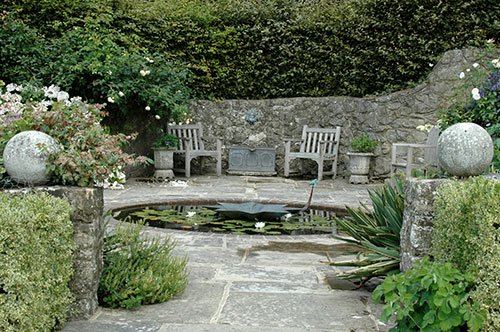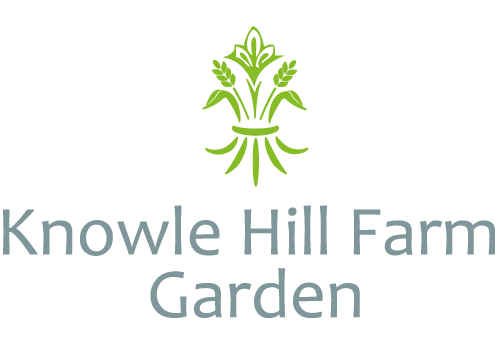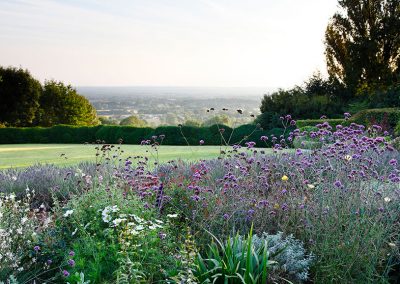Garden History
The 2 acre garden at Knowle Hill Farm has been lovingly created from scratch over 35 years by Elizabeth and Andrew Cairns but this could not have been done without the help of our wonderful part-time gardeners Jacky and Mike. Now it is mature but there always seems to be a project under way. The latest are some new steps beside the house and a beautiful new water feature.
The garden won first prize in the Kent Life amateur Garden of the Year in 2012 and has featured in Country Life, The English Garden and Country Living magazines.
The garden gives us so much pleasure and occupation and we love welcoming visitors to share it with us.
A tour of the garden
Wind and views
The old (15C) house stands just below the greensand ridge overlooking the weald of Kent. The view is spectacular and remarkably unspoilt though we are only 50 miles from the centre of London. The garden faces south west and the soil is light and sandy over the ragstone bedrock. The Ph is 7 – 7.5 so we do not grow anything which dislikes lime. The focus of the garden is the view but a view, as Russell Page remarked in The Education of a Gardener, “usually means wind, and a windy garden is unrewarding”. We have done our best in the 37 years we have lived here to reduce the impact of the south westerly winds by planting a shelter belt on the western boundary and gradually building up a framework of wind tolerant shrubs and trees while preserving the view. Occasionally the wind blows hard through the garden but with far less devastating effects than before.
We have followed Page’s advice in not allowing any planting to distract from the view which is seen from a broad sweep of grass which falls away, following the natural contours in front of the house, to a boundary of ancient box (buxus sempervirens) which over the years has formed a sculptural billowing shape long before cloud pruning became fashionable. Two large groups of the gorgeous rose ‘Nevada’ provide a touch of gentle colour in early June and Rosa ‘Wedding Day’ has climbed high into an ancient pear tree and scents the air later in the month.
Around the house
The entrance drive was created in 2004 from the old farm yard. The planting is intended to be relatively low maintenance. It comprises ribbons of roses, lavenders, potentilla, heuchera, box and heather punctuated with huge ragstone boulders which were excavated during the work.
We have made small areas for sitting out close to the house, paved with brick and stone and made formal with clipped box and bay. Here we stand pots filled with tender plants in summer and bulbs in spring. A tiny herb and salad garden is conveniently next to the kitchen. A long bed of white and purple lavender runs in front of the house and sets it securely in the landscape.
In front of the house a paved area edged with box ‘Blauwe Heinz’ and topiary spires in golden box is now too shady to be planted with summer bedding, as we originally planned, because the old yew tree has grown so prodigiously over the years but ferns and other foliage plants provide a more subtle though less colourful appearance. A tiny paved area on the east side of the house is restricted to a restful palette of green and white with clipped bay trees and box spirals rising above the green foliage encircled by a box hedge with a wavy top (an idea taken from the wonderful Jardin Plume).

Colour schemes
The front lawn is edged by a long scalloped bed planted with yellow, orange, purple and blue shrubs and perennials among them the somewhat tender shrub, Cestrum parqui, bought many years ago from Great Dixter which dies away completely each winter and springs back into verdant life again in summer. An immense clump of the orange lily Henryi which has never been touched since it was planted some 25 years ago forms a spectacular sight in July and in August the agapanthus are magnificent.
Further down the garden a small walled garden with a pool and surrounded by a hornbeam hedge has been planted with white and blue flowering plants including Corydalis flexuosa, Yuccas, roses ‘Iceburg’, ‘Sombreuil’ and ‘Winchester Cathedral’. Trachelospermum jasminoides and blue and white clematis clothe the walls.
Wild flowers and snowdrops
On the east side of the garden and separated from it by a yew hedge a wildflower meadow with tightly mown paths is at long last living up to its name. It has been a struggle to establish the fine grasses and native flowers because of the residue of course grass and weed seeds in the soil but the introduction of yellow rattle has done wonders and recently it has looked quite pretty with cowslips, Queen Anne’s Lace and early bulbs. A collection of China roses enjoys a sunny sheltered bank behind the Mulberry tree which was planted in 1991.
On the other side of the garden a carpet of snowdrops covers the ground beneath the shelter belt which provides hope and cheerfulness in February. Over the years we have become infected by the fashionable craze for collecting snowdrops and we are now true galanthophiles. We have more than 100 different varieties which we have planted all around the garden and can never resist adding to the collection.
The upper levels
Behind the house a south facing bank provides a warm dry environment for lavenders, salvias, roses and shrubs in shades of pink and purple interplanted with grasses, agapanthus, hebes and bulbs. Roses ‘Cerise Bouquet’ and Felicite Perpetue soar into the shrubs which provide shelter for the area above.
A flight of steps leads up the bank to the top part of the garden, the only level area we have. A border planted in shades of red and purple flanks one side of the lawn at the top of the steps where we have some nice red roses such as ‘Dusky Maiden’, Roundelay, Munstead Wood and L.D. Braithwaite. It is more shady here allowing us to grow some hydrangeas, hostas, hellebores and primulas but the main walk, marked out by clipped box contains roses, salvias, yuccas and lavenders. A yew hedge encircles a statue sculpted by our son which provides an eye catcher at the end of the main walk.
The benefits of age
The garden is now more than 35 years old and some shrubs have grown into substantial specimens. Olearia macrodonta, Leptospermum lanigerum, Cotoneaster lacteus, the beautiful yellow magnolia “Lois’, Cratageus Prunifolia and Prunus shirofugen are all now rather magnificent.


















